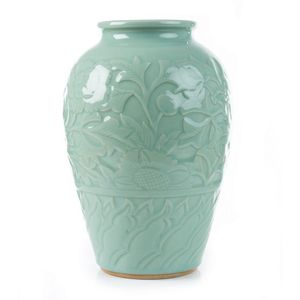Taisho Kyoyaki Celadon Vase with Art Deco Influence
You must be a subscriber, and be logged in to view price and dealer details.
Subscribe Now to view actual auction price for this item
When you subscribe, you have the option of setting the currency in which to display prices to $Au, $US, $NZ or Stg.
- Art Deco Period - The Art Deco period was a cultural movement that emerged in the 1920s and 1930s, and was characterized by its emphasis on modernism, luxury, and elegance. The name "Art Deco" comes from the Exposition Internationale des Arts Décoratifs et Industriels Modernes, a large exhibition held in Paris in 1925 that showcased the latest trends in decorative arts.
Art Deco was a reaction against the ornate and elaborate styles of the previous era, and reflected a new modern sensibility. It was characterized by streamlined, geometric shapes, bright colours, and the use of new materials such as chrome, glass, and Bakelite. Art Deco designers sought to create a sense of luxury and sophistication, often incorporating expensive materials such as ivory, marble, and rare woods.
Art Deco had a significant impact on a wide range of artistic fields, including architecture, fashion, graphic design, and interior design. Some of the most iconic examples of Art Deco architecture include the Empire State Building in New York City, the Hoover Building in London, and the Palais de Chaillot in Paris.
The Art Deco period came to an end in the 1940s, as World War II and changing cultural trends led to a shift in artistic styles. However, Art Deco remains an important influence on design and art, and continues to be celebrated for its modernist sensibility and glamorous aesthetic. - Circa - A Latin term meaning 'about', often used in the antique trade to give an approximate date for the piece, usually considered to be five years on either side of the circa year. Thus, circa 1900 means the piece was made about 1900, probably between 1895 and 1905. The expression is sometimes abbreviated to c.1900.
This item has been included into following indexes:
- Japanese ceramics, factories and cities - Kyoto, Kyoyaki and Kyo-yaki wares 92
- Japanese ceramics, styles and decoration - celadon glazed 47
-
Satsuma (Japan), item type
- other items 2,034
- vases 1,376
Visually similar items

A Cizhou meiping with turquoise glaze, Yuan Dynasty 22.8 cm high

Moorcroft vase by Rachel Bishop with tubelined floral detail, stamped & impressed marks to the base. Height 30.5 cm

Daum, Nancy clear glass vase, signed in script, French, 20th century, 26 cm high

Moorcroft 'Anemone' vase having pink & purple flowers on a cobalt blue ground, marked stamp 'Moorcroft made in England', with original sticker. Condition: good, minor wear to the base. Height 18.5 cm
